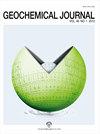几种重要硫化物的平衡硫同位素分馏
IF 1.6
4区 地球科学
Q3 GEOCHEMISTRY & GEOPHYSICS
引用次数: 6
摘要
日本地球化学学会版权所有©2021。硫同位素分析已应用于矿床;这一学科领域的先驱是Kulp等人(1956)和Jensen(1957, 1959)等人。目前,硫同位素应用于地质学(如Shanks等,1981)、生物学(如Rees, 1973;Habicht and Canfield, 1997;Habicht et al., 1998;Bolliger et al., 2001;br本文章由计算机程序翻译,如有差异,请以英文原文为准。
Equilibrium sulfur isotope fractionations of several important sulfides
Copyright © 2021 by The Geochemical Society of Japan. sulfur isotope analyses have been applied to ore deposits; the pioneers of this subject area are Kulp et al. (1956) and Jensen (1957, 1959), among others. At present, sulfur isotopes are used in the fields of geology (e.g., Shanks et al., 1981), biology (e.g., Rees, 1973; Habicht and Canfield, 1997; Habicht et al., 1998; Bolliger et al., 2001; Brüchert et al., 2001; Detmers et al., 2001) and environmental science (e.g., Harris et al., 2013), etc. Notably, research on the mass-independent fractionation of sulfur is currently the most active topic in the field of sulfur isotope geochemistry (Farquhar et al., 2000, 2001, 2013; Savarino et al., 2003; Subrata et al., 2013). It is well known that equilibrium isotope fractionation can be used to estimate the formation temperature of minerals in geological systems (Urey and Greiff, 1935; Urey, 1947). Isotope geochemistry mainly focuses on the change in the isotope ratio between different species rather than on their absolute abundances. The general rule for isotope fractionation is that heavy isotopes tend to form more stable chemical bonds; for example, M34S is more stable than M32S (M stands for metal cations). When considering kinetic isotope effects, molecules with different isotopes have different reaction rates (O’Neil, 1986). In the case of sulfur, 34S/32S is the key point of interest. In most cases, isotope fractionation is relatively small, and most of the time, the δ notation is used to express isotope fractionation. In this article, only the ratio of 34S/32S is Equilibrium sulfur isotope fractionations of several important sulfides
求助全文
通过发布文献求助,成功后即可免费获取论文全文。
去求助
来源期刊

Geochemical Journal
地学-地球化学与地球物理
CiteScore
1.70
自引率
12.50%
发文量
11
审稿时长
6 months
期刊介绍:
Geochemical Journal is an international journal devoted to original research papers in geochemistry and cosmochemistry. It is the primary journal of the Geochemical Society of Japan. Areas of research are as follows:
Cosmochemistry; Mineral and Rock Chemistry; Volcanology and Hydrothermal Chemistry; Isotope Geochemistry and Geochronology; Atmospheric Chemistry; Hydro- and Marine Chemistry; Organic Geochemistry; Environmental Chemistry.
 求助内容:
求助内容: 应助结果提醒方式:
应助结果提醒方式:


